

How to Prepare Actionable PhD Research Plan Template
“Where PhD is highly uncertain, an actionable PhD research plan would give you calculative and tentative outcomes. And even more, the ready-to-use template makes things even better. Let’s take a close look at the research plan + template.”
Before moving forward, it’s important to understand the process and steps in research . Then only you can make an actionable plan for your PhD research. It’s literally like driving without breaks— that you don’t want.
In a broader sense, when you plan something, it shows two things: first, you are actually serious about the work you are planning and second, you are expecting some outcomes. And by a plan, you are heading towards it.
I know, plans may not work 100% all the time, but they may create a definite path to achieve at least 80% success in the work you are doing. This is also true for a PhD— in which you would constantly try to justify a single sentence– your research title.
So– Yes, the research process is undetermined and so the results too! but here is the catch and perhaps answer why you have to have a research plan. In this article, I will explain the importance of a research plan, an actionable research plan and a ready-to-use template for you.
How to prepare an actionable research plan?
Importance of phd research plan , wrapping up.
An actionable research plan is what you have to rely upon. So it should be perfect and approved. how can you prepare your own? Let’s see.
Understand the steps in the research and closely follow them.
Define the objectives and scope of your study.
Define each goal of your study– For example, sample collection, wet lab work, standardization, experimentation, data collection and interpretation, etc.
Enlist what types of problems you may face for each goal– For example, transportation for sample collection, Lack of facilities in wet lab work, etc.
Find a solution for each problem you have enlisted– For example, appoint an expert for sample collection and transport samples in a cold chain. If your lab doesn’t have some instruments or chemicals, priorly contact other labs and ask them for help.
Draw a rough road map for your work— the route using which you will achieve your research goals. Also, make a backup. What if the route or process you selected would not work? Check out this drawing to understand my point.
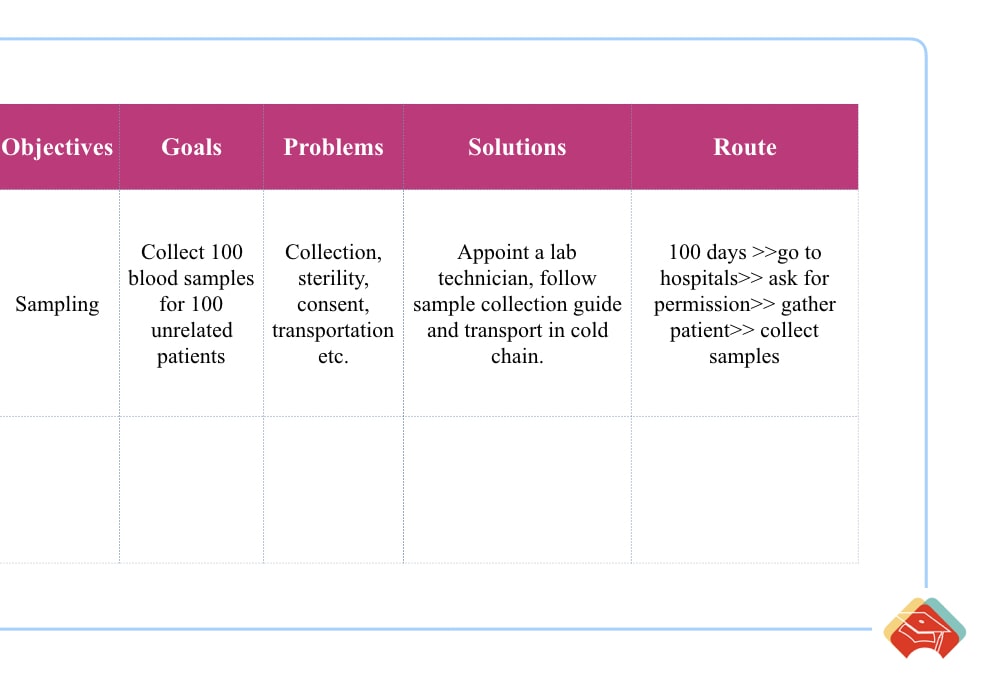
Now prepare a timeline— in how much time a particular goal should be achieved. For example, 6 Months for sampling (Including, ethical approval, approval from sampling authority, consent, preparation and arrangement for utilities).
Another is sample collection— 3 Months which isn’t covered in the 6 months of sampling objective, like this. Take a look at the drawing here.
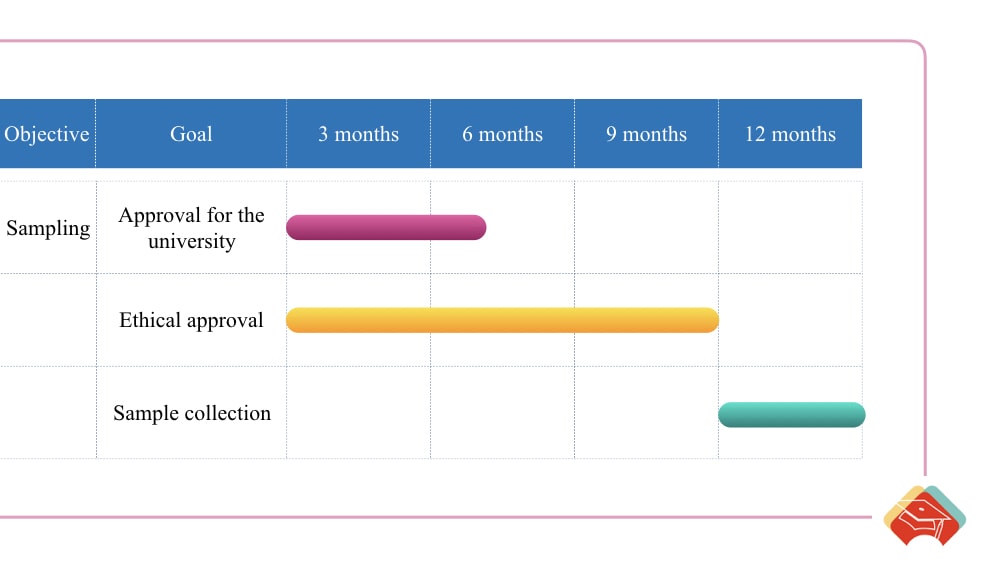
Note: This timeline must match with your GANTT chart for PhD timeline because you are making an actionable plan.
Now your plan is reading. You are now aware of each objective, goal and problem. Some you probably solved, and some you can manage later. This you can print and stitch in your logbook or can save on your desktop.
Take a look at the advantages, and why it’s important to prepare an action plan.
Related article: How to Prepare a PhD Research Plan/Schedule?
Let’s start with two real-world examples first.
One of my friends, after sample collection and initiating the testing, found out that she also has to perform hormone assays for samples. The samples she collected are 3 months old— not possible to assess quantitative analysis.
Another colleague after sample collection– when he started working in the wet lab, came to know that one important instrument is not there in their lab. His guide is very serious about the goal that they have to do it anyhow.
He sent applications to various universities and research centers to work on that particular instrument. From approval to real testing, it tools all almost 8 months including, approval, training, transportation, etc.
Wasted much time!
- An actionable research plan saves your time— which is a crucial factor in PhD.
- It makes you aware of the pros and cons of your study.
- It makes you aware of the problems and limitations of the research you conduct.
- It gives you a broad roadmap to achieve your PhD in “some” tentative time.
- It gives you the flexibility to achieve goals and enjoy your time at the same time.
- You can make real-time monitoring of how your research is going and how much work is left.
- It makes you aware of what should be your next move and the preparations you required.
However, keep in mind that once you prepare a plan, review it from your guide, take their advice, enlist major objectives and techniques you would use for the study and stick to it.
Before preparing that, read the literature regarding your topic and understand the way in which your research should be headed.
Check out our fully customizable, ready-to-use and actionable research plan template.
Download a research plan template
These things look a bit old school but it works, really works well. Most students don’t do it and end up messing things and at last, came to know that they wasted their time. At least, the research plan will tell you where you are stuck (probably) and you can find a solution.
We know how hard it is to predict the future of PhD or how it would go. But let me tell you, with an actionable plan, many do well. And you can too. Take your doctorate seriously from day one. And do accordingly.
Remember your goal should be to complete your degree in time.

Dr. Tushar Chauhan is a Scientist, Blogger and Scientific-writer. He has completed PhD in Genetics. Dr. Chauhan is a PhD coach and tutor.
Share this:

- Share on Facebook
- Share on Twitter
- Share on Pinterest
- Share on Linkedin
- Share via Email
About The Author

Dr Tushar Chauhan
Related posts.

A Definite Research Process for PhD- What Students Should Know?
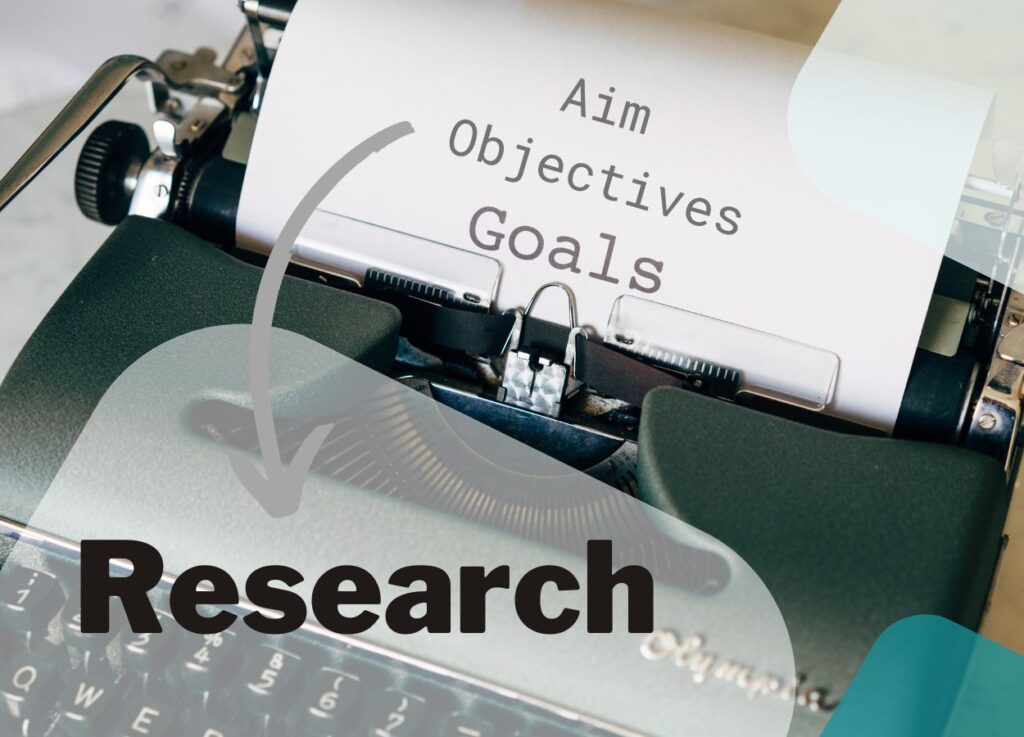
What are Research- Aim, Objectives, Tasks/Goals? [Our System]
Leave a comment cancel reply.
Your email address will not be published. Required fields are marked *
Save my name, email, and website in this browser for the next time I comment.
Notify me of follow-up comments by email.
Notify me of new posts by email.
How to develop an awesome PhD timeline step-by-step

Why a clear PhD research timeline matters
A PhD timeline breaks down the daunting task of doing a PhD into an actionable plan with tasks and milestones along the way.
Step 1: Decide what to include in your PhD timeline
Make a draft plan, including dates and times. Then move to Step 2: Discussing it with your supervisor/s!
Step 2: Discuss your provisional PhD timeline with your supervisor/s
Make sure to take notes during the meeting, as you will need the answers to these questions to edit your provisional PhD timeline.
Step 3: Design your PhD timeline
A well-designed PhD timeline is not just pretty for the eyes, but it makes it much easier to have a good overview of all plans and milestones ahead.
Yet, it would be wrong to argue that there is a one-size-fits all solution to designing a perfect PhD timeline.
Step 4: Regularly update your PhD timeline
Your PhD timeline should be a living document or chart. Update it regularly!
Master Academia
Get new content delivered directly to your inbox, left your dissertation too late ways to take action now, the best email signatures for graduate students (with examples), related articles, separating your self-worth from your phd work, how to introduce yourself in a conference presentation (in six simple steps), 17 strong academic phrases to write your literature review (+ real examples), how to organize and structure academic panel discussions.

How to plan, structure and write every chapter in your PhD
In this collection, we’ll walk you through each chapter of your thesis. You’ll learn what goes where and how it fits together.

The PhD Discussion Chapter: What It Is & How To Write It
Your PhD discussion chapter is your thesis's intellectual epicenter. Think of it as the scholarly equivalent of a courtroom closing argument, where you summarise the evidence and make your case. Perhaps that’s why it’s so tricky - the skills you need in your...

Everything you wanted to know about structuring your PhD but were too afraid to ask
Understanding how to structure your PhD is tough. It helps to break it down into four distinct sections. In this guide, we explain how.

How to find the thread that runs through your PhD thesis
You probably worry about finding the thread that runs through the PhD thesis. In this guide we walk you through what’s required.

How to edit a PhD thesis (without going mad)
Your thesis takes a lot of time to research, ideate, and write. Here’s how to properly edit a PhD thesis such that you impress your examiners and achieve even greater success.

The 9 most effective ways to achieve PhD success
Writing a PhD is physically, intellectually and emotionally daunting. You may spend each day doubting yourself, not sure if you’re making the right choices and unsure whether you’ve got what it takes. During my life, I’ve helped thousands of PhD students like...

How To Structure A PhD Thesis
Struggling to understand what goes where? Let us walk you through a non-nonsense guide that’ll teach you how to structure a PhD thesis.

The difference between empirical and discussion chapters (and how to write them)
There is a very important distinction that needs to be made between the empirical and discussion sections/chapters. It is a common misconception that the empirical chapters are the place for your analysis. Often this confuses the reader.

Five tips to improve your PhD thesis
Regardless of what stage of the writing process you are at, there are five overarching tips you need to keep in mind if you want to improve your PhD thesis.

What are you doing and how are you doing it? Articulating your aims and objectives.
How long does it take the person reading your thesis to understand what you’re doing and how you’re doing it? If the answer is anything other than ’in the the opening lines of the thesis’, keep reading.

Learn how to write a PhD proposal that will stand out from the rest
When stripped down to its basic components, the PhD proposal explains the what and the why of your research. What it will be about and why it will be important.

Easily understand how to write a PhD thesis introduction
Get the introduction right and the rest of your dissertation will follow. Mess it up and you’ll be struggling to catch up. The introduction is the place to factually recount what it is you will be discussing in the thesis. Learn more in this detailed guide.

Last impressions count – writing your PhD thesis conclusion
The conclusion is the last thing your examiner will read before they write their viva report. You need to make sure it stands out.

What is a dissertation abstract and how do I write one for my PhD?
Don’t underestimate how hard it is to write a PhD thesis abstract. When I wrote mine I though it’d be straightforward. Far from it. It’s tricky. You have to condense hundred of pages and years of work into a few hundred words.

Russian (dolls) to the rescue – how to structure an argument in your PhD
At the core of the PhD are arguments. Lots of them. Some more important and some very specific. When you understand how to structure an argument, your thesis reads clearly and logically. If you don’t the reader ends up confused and your thesis suffers.

Drowning in a sea of authors – How to be critical in a PhD literature review.
Don’t get lost in a sea of authors when you write your PhD literature review. Instead be critical. In this guide we explain how.

Wrestling an elephant into a cupboard: how to write a PhD literature review in nine easy steps
When I was writing my PhD I hated the literature review. I was scared of it. I thought it would be impossible to grapple. So much so that it used to keep me up at night. Now I know how easy it can be and I’m sharing my top tips with you today.

A Template To Help You Structure Your PhD’s Theoretical Framework Chapter
In this guide, I explain how to use the theory framework template. The focus is on the practical things to consider when you’re working with the template and how you can give your theory framework the rockstar treatment.

How To Structure A PhD With Our PhD Writing Template
Our PhD Writing Template allows you to visualise your PhD on one page. Here we explain how to fill it in and how it can help you structure each chapter.

Eureka! When I learnt how to write a theoretical framework
The theoretical framework is so important, but so misunderstood. Here we explain it is in simple terms: as a toolbox.
Explore Other PhD Knowledge Base Collections
Eight collections of free resources to help you along the phd journey.

Mastering your theory and literature review chapters

How to structure and write every chapter of the PhD

How to stay motivated and productive

Techniques to improve your writing and fluency

Advice on maintaining good mental health

Resources designed for non-native English speakers

Explore our back-catalogue of motivational advice
Each week we send out a short, motivational email to over 4,000 students. Here you can sign up and access the archive.

A free one-page PhD structure template

154. How to Plan Your PhD w/ Hugh Kearns
Podcast: Play in new window | Download
Subscribe: Spotify | Email | TuneIn | RSS
A PhD Plan sounds like an oxymoron, but charting a path to graduation is one of the most important things you can do as a graduate student.
This week, we talk with Hugh Kearns of Thinkwell about why PhD planning is so challenging for students, and learn about some tools that can keep your research on track.
Uncharted Territory
We start the conversation by trying to understand why planning is so difficult and so rare for PhDs.
“They’ve never done a PhD so they don’t know what’s coming,” Kearns observes. “And your previous education doesn’t prepare for research.”
He continues, “Research by its nature is uncertain. Things go wrong. And then what happens is people think that ‘Because I don’t know, we just won’t plan anything! We’ll see what happens.'”
But just because you’ve never done a PhD before, and no one has pursued your particular branch of research, that doesn’t mean you can’t plan ahead.
In fact, there are already tools and strategies, adapted from project management in the business world, that will help you set some guide rails around your winding path to a PhD.
Getting Your PhD Plan Backward
Traditional ‘forward’ planning works great for a well-worn process, like building a house. Builders know from experience that you can’t build the walls until you’ve poured the foundation, and you can’t paint until the drywall is installed.
Each of those activities has a reasonably predictable timeline, so you can plan the construction of a home week by week until it’s finished.
But a PhD isn’t quite at prescriptive. Sure, you know you need to do a literature review, but how long does that take? And how long will experiments take?
The fact is, they’ll take as much time as you give them. There’s no definitive ‘finish line’ for a literature review the way there is for a construction project. You just need to decide how long you’re willing to give the review, and stop when it’s ‘good enough.’
That’s why Kearns recommends ‘backward planning’ for PhDs. You start with an end date in mind (usually when the funding runs out) and work back from there.
His book, Planning Your PhD: All the tools and advice you need to finish your PhD in three years , lays out the steps in detail, and provides some worksheets you can use to create a multi-year Thesis Plan .
In fact, he offers those worksheets for free on the website!
Drilling into Detail
With your Thesis Plan in place, you can begin the process of adding more and more detail to the events closest in time.
This ‘rolling plan’ recognizes that you don’t know what you might be doing on Tuesday March 25 at 3PM three years from now, but you CAN decide on some goals over the next six months.
And don’t stress out if those goals shift, or you don’t quite manage to meet them. If you revisit your plan on a regular schedule, you can adjust and adapt.
If you never set the goal, or never look back at what you planned, you’re guaranteed to drift as the months and years pass by.
Kearns shares some other tools, like his ‘To Day’ list that works in conjunction with your ‘To Do’ list to put a time component on your tasks. That way, you slowly make progress toward your goals, rather than watching your list grow more and more unmanageable.
The Paradox of Choice
Finally, we talk about the surprising fact having more options usually means you are less happy and get less done. Weird, right?
It’s the ‘paradox of choice,’ described by Barry Schwartz in his 2004 book of the same name, and this TED Talk .
For graduate students, that manifests as a list of things you need to get done: pour a gel, set up those reactions, manage the lab animals, read three papers, write a section of a review, respond to your PI’s email, and on and on.
And what happens when you have all those things you COULD be doing? You get overwhelmed and go scroll through Instagram instead.
Kearns recommends that you identify ‘The Next Thing’ (or TNT) and work on that. The smaller you make that task, the better!
We’ve learned over the years that PhD students don’t understand the meaning of the word “small”. Because they’ll say, “OK, I know what the task is: I’ll finish my literature review”. But this is still way too big. So now we use the word micro-task. For example, some micro-tasks are: * Add two paragraphs to the discussion section * Add the new data to Table 1 * Read my supervisor’s comments on my draft Planning Your PhD, by Hugh Kearns and Maria Gardiner
Keeping ‘The Next Thing’ manageable prevents your brain from shutting down and giving up.
And if you stack up enough ‘The Next Things’, day after day and week after week, you’ll soon be making measurable progress on your PhD!

One thought to “154. How to Plan Your PhD w/ Hugh Kearns”
There’s so many people that I’ve already approached and address the subject, and while it’s still needs to be addressed and is of great value to younger grad students… There’s something that I have experienced two times in my graduate student career, that I’ve yet to hear any academic institution discuss… What happens, when you are left alone when your advisor dies, and/or commits suicide? I realize this is a very small population of the onions that you speak to, but to those of us that I’ve gone through this, it is absolutely devastating. I’m the first person from my family to go to college, let alone grad school. Trying to finish my PhD was absolutely, not supported the least. When my advisor died it just sent things out of control. So, how do you propose to integrate maybe even in a small portion… However uncomfortable it may be, if a student is to be in such a situation where their advisor dies, And they are not receiving any support by their department which leaves them in even greater shock.. And perhaps I need them selves in limbo for years. This is what happened to me. But I had extenuating circumstances. I fought as hard as I could, While escaping a very unsafe home situation… Essentially, how do you bring up these topics for students for the worst possible case scenario for when things go wrong? Hopefully, they never do reach a point Were you have to learn that your advisor died or that you were advisor completed suicide in one of the parking garages is in your university. If you happen to plan your research out, let’s say perfectly; you have five research papers and you were on track to graduate and you were ready to give your defense And anticipated your graduation to be the next upcoming semester. You did everything right. Your plan worked. You follow the rules. What advice for students would you suggest, to prevent them from essentially falling apart completely? Because at the end of the day they put their entire lives into what they are doing here to finish up and move on with their lives. They put relationships and marriages and children on hold… So what happens when a disaster strikes? I think that should be a topic you might want to touch on in the future. Like I said, might be a small demographic, but I lost 1 advisor suddenly, An excellent professor to suicide, a remarkable and rising star an excellent lab-mate to suicide as well. I think that if we can integrate mental health and just kind of trickle it into conversations more, and dedicate more time to Just discussing it, and just discussing that mental health is as important as physical health… mental health won’t be as stigmatized as it unfortunately still is at this very day. Overall, I’m happy about the topic of this episode and this podcast in general. However, I think there are modern in inclusive pathways and things that Students really need help with especially regarding mental health and support… Especially when the loss of a lame or a advisor or a loved one… If any of this occurs, and they feel like they cannot reach out, that can be detrimental to your perfect research plan. So at the end of the day, your research plan could mean absolutely nothing. You have to essentially plan for the worst. Sounds sounds like a very pessimistic thing, I understand. But having gone through this myself, I don’t want anybody to ever experience what I have. We can only start making these extreme cases easier to deal with by Integrating it in our discussions. After all, it is quite relatable to your planning of your research and your PhD career. Because when your world gets turned upside down, your “plan” Could be dead or worthless. So where do you go from there? Just trying to provide a thought on my own take Hope it helps thanks for the podcast.
Leave a Reply Cancel reply
Your email address will not be published. Required fields are marked *
This site uses Akismet to reduce spam. Learn how your comment data is processed .

- All archive
- Mental Health
- Soft Skills
- Project Management
- For Switzerland
- Social Media
Select Page
Guidelines to draw a timeline of your PhD
2018 Nov 20 | Resource , Soft Skills | 0
In a previous article I talked about how project management can help reduce PhD students’ anxieties . Most of my PhD I felt very much confused. Sometimes I could not even say whether I was still in the beginning, somewhere in the middle or close to the end of it. Therefore, I suggested that supervisors and students should try to define a tangible objective early on in the doctoral process, and that they should have regular check-point meetings to adjusts plans in order to keep the student’s project on track. I also mentioned that it is highly important to clarify what the supervisors and students long-term expectations are .
In another article I talked about Gantt charts , a great project management tool to draw and visualize a project outline.
Do you see where we’re going here? Let’s draw a timeline of your PhD in the shape of a Gantt chart! I know, it’s in the title ;)
In this other article about Gantt charts, I explained that there are some drawbacks to keep in mind. Indeed, upfront planning techniques like Gantt charts tend to lack flexibility and when things don’t work as planned it can actually increase the feeling of failure, which is exactly what we want to avoid here.
So, does it even make sense to draw a timeline early on in the doctoral process? I believe it does! We can keep the drawbacks of Gantt charts in mind and draw such a timeline if we define guidelines of how to use it .
- Example & download
- Why draw a timeline?
- Guidelines for how to make & use the timeline throughout your PhD
1. Example & download:
I draw below an example for the institute where I did my PhD: the Institute of Biology at the University of Fribourg in Switzerland. Therefore, it is designed for a 4-year PhD program with annual committee meetings and for students who spend a lot of time performing lab experiments . However, it can be easily adapted to any field or any doctoral program.
You can download for free the Excel file I used to make this timeline by clicking here .
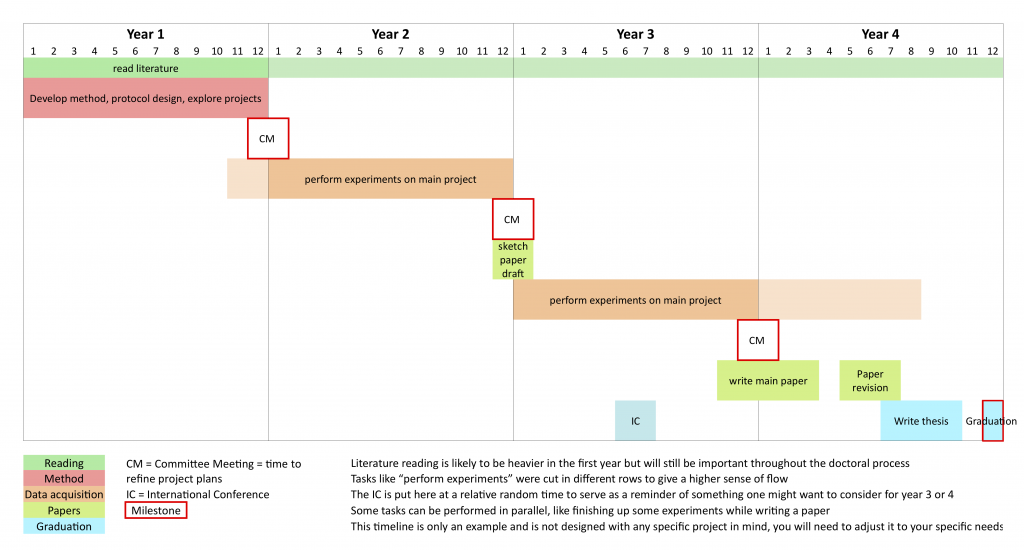
Because I want this to be a general example but also because it is such a long time scale, I kept the level of detail to the minimum to make it flexible and to avoid over-planning . The time for each task here is a very rough estimate, it is meant to be adapted to what you think is best for you or to what is expected in your doctoral program. Importantly, the uncertainty level is increasing with time . You don’t have to start writing a paper on the 11th month of your third year, maybe you’ll start much earlier or much later and it will be perfectly fine. This is just a broad overview to help visualize what the main steps are, but their exact length or when they should start will get clarified once you are closer to it.
2. Why draw a timeline?
To draw such a timeline and for it to be realistic and useful, you are going to ask very concrete questions, to yourself and to your supervisor , like what are the important steps, what are the milestones (technical milestones for developing a protocol, committee meetings, exams…), what are the risks, do you have only one project or do you have more, maybe one large risky project and one smaller safer project, and all other questions which are relevant to you.
Project management is effective if concrete questions are openly discussed. If your supervisor doesn’t bring up these questions with you, it might feel quite scary for you to ask for it. To help you find the courage to so, I believe that having such a timeline will provide you a highly visual and attractive medium to foster these discussions.
When I learned about Gantt charts at the beginning of my second year of PhD studies, I draw myself such a timeline, but I didn’t dare to discuss it with my supervisor. With no surprise things really didn’t work out the way I planned it. Supervisors by default have more experience than a junior PhD student so they should know better what is realistic, what is expected and how much upfront planning can be done depending on the project.
3. Guidelines for how to make & use the timeline throughout your PhD:
- I suggest that you draw a first version within the first two months of your PhD . But it’s never too late to start =)
- Take my example and adjust it , maybe you already have a clearly defined project, maybe not, maybe you don’t need to design a new method, maybe you’ve been included in someone else project with a clear short-term objective, maybe you think you should start drafting a paper earlier, go and adjust it to what feels right to you.
- Make sure to keep in mind that this chart is going to change many times until you graduate, stay flexible. This first timeline should only be an overview of the main steps which you expect in your PhD. It is here to give a direction, and if used regularly it can give a feeling of moving forward.
- Schedule a meeting with your supervisor to discuss this initial timeline ( still within the first two months ), ask the maximum of questions, clarify the maximum of points and make sure you both agree.
- Then whenever needed, go back to it and adjust it, maybe there is a great collaboration opportunity and for a few months you’ll be asked to put your main project aside and work fully on this collaboration, maybe your new protocol is working great and you’re already getting publishable data, maybe the protocol is not working well and you need to change strategy, how does it affect your timeline?
- Whenever a big change happens or whenever you feel too lost, schedule an extra meeting with your supervisor to specifically discuss the timeline and the long-term objectives. Hopefully it should give you a feeling of being on a track, even if it’s not the first one you pictured.
- I would suggest having such a discussion at least every 6 months .
This timeline is now a tool which is going to grow with you throughout your PhD. At first it is a rough overview of the main steps, if you keep it update with what you really do, at the end it will be a true overview of everything you’ve accomplished. Therefore, on top of guiding you through it, it will become a great tool to look back at your PhD experience once you’re finished.
Thanks for reading and I hope these ideas can help you :)
Make sure to read my previous article about Gantt charts where I explained that it can be used both for long-time scale like here, or on shorter time scale (like 2 months) with a higher level of detail.
Looking for more reading about project management for research? Have a look at the resource I made Project Management resource for PhD students and supervisors !
If you subscribe to the newsletter you’ll get my articles in full text directly in your inbox, no need to come on the website anymore, you might miss out my great pictures though… ^^
Thanks! Please check your email inbox or spam folder and click the link to confirm your subscription.
Related Posts

Career Services for PhDs in Swiss Universities and HE

Academics: you already have more soft skills than you think and you can prove it

Coaching program for PhD Students in Fribourg (CH)

General info about Academic Funding for ECR in Switzerland
Leave a reply cancel reply.
Your email address will not be published. Required fields are marked *
Subscribe to the newsletter
This site uses Akismet to reduce spam. Learn how your comment data is processed .
- PhD Program Plans
[Part of the Policies of the CHD, August 2019]
Prospective Ph.D. Program Plan: Spring of G1 year
By mid-semester of the Spring of the G1 year, students should submit a Prospective Ph.D. program plan. The Ph.D. program plan specifies the ten SEAS graduate-level half-courses, or acceptable alternatives, be taken to satisfy the course requirements for the degree. The plan should contain a Proposed Dissertation Topic / Area of Research. The plan should be supplemented by a statement to explain the area of interest and the educational rationale for the courses included in the program. A major test of a program's intellectual validity is the possibility of providing a rational and persuasive argument in its favor. Supporting statements by the student's advisor(s) may also be necessary. The explanatory statement should be as brief as is consistent with clarity and completeness.
After consultation with their first-year advisor, the student will submit the Ph.D. program plan form by the announced deadline, usually in March of the G1 year. If necessary, the Application for Academic Credit for Graduate Work Done Elsewhere form also should be completed and attached to the prospective plan.
After reviewing the prospective program plan, the CHD may suggest or require modifications. It is in the best interest of the student that the prospective program plan be submitted as early as possible, during the first semester if possible; in no case may submission be delayed beyond April of the G1 year. An approved prospective program plan is normally a condition for registration for a third semester.
At any time after approval of the prospective program plan, changes to it are subject to approval by the CHD.
Ph.D. Program Plan (including qualifying exam committee): Fall of the G2 year
In consultation with the research advisor, the student will submit the Ph.D. Program Plan form by mid-November, preferably earlier. The final program plan serves two purposes: (1) it updates the prospective program plan by noting any revisions to the ten courses to be taken, and (2) it serves to form the qualifying exam committee. The committee includes the research advisor and nominations by both the student and the research advisor of one member each. The CHD reviews the final program plan and, on behalf of the Dean, nominates a fourth member for the qualifying committee, who is a SEAS faculty member
An approved final program plan is normally a condition for registration for a fourth semester.
In Academic Programs
- Non-Resident and Part-Time Study
- CHD Meeting Schedule
- PhD Overview and Timeline
- PhD Course Requirements
- Teaching: G2 year
- Qualifying Exam: by end of G2 year
- Research Advisors, Committees, and Meetings
- Dissertation and Final Oral Exam
- SM and ME Course Requirements
- SM and ME Program Plans
- Masters Thesis and Supervisor
- SM degree en route to the PhD
- Graduate Student Forms
- Teaching Fellows
- External Fellowships List
- COVID-19 Graduate Program Changes (archived)

How to Write a PhD Research Proposal

Starting on PhD research is a big step in a researcher’s academic journey, and submitting a research proposal is a significant part of it. Indeed, many PhD scholars seek guidance on how to write a PhD research proposal , which is the foundational document that outlines the scope, objectives, and methodology of their prospective doctoral study. This article takes a look at the essential elements of a PhD research proposal and discuss practical steps to help develop an effective and strong document.
What is a PhD Research Proposal ?
Think of a PhD research proposal as a blueprint for your research. It lays out the main questions you want to seek answers to in your study, and presents an overview of the field you are planning to dive into. The PhD research proposal is not just about summarizing what is already available in the public domain. It is a critical document that demonstrates the feasibility, significance, and originality of the proposed research, and therefore, plays a crucial role in influencing admission decisions and securing funding opportunities. It also explains how your research is different and new and underscores the unique angles, perspectives and originality of your area of study.[ 1]
Why is a PhD Research Proposal Needed?
Even though your research proposal focuses on what you plan to do in the future, supervisors and funders also want to see what you have already achieved academically. Their interest lies in how well you understand the existing research, including recent studies and discussions in your academic field.
Therefore, it is essential to showcase your awareness about gaps in current knowledge and how your research will develop new knowledge and perspectives. Presenting a clear and detailed picture of this background is critical.[ 2]
How to Structure Your PhD Research Proposal ?
Research proposals can vary based on the institution you wish to send the proposal to or your subject of study, but there is a broad structure that needs to be followed.[ 3][4][5] A good PhD research proposal structure should highlight what makes your idea unique, feasible, and significant.
Follow these proven tips to structure a PhD research proposal and make it stand out:
- Provisional Title: The title should not only describe the subject matter but also hint at your approach or main question.
- Key Question: The key question is crucial for defining the scope and purpose of the research, making sure everything stays clear and organized.
- Topic Description: This section serves to introduce readers to the topic being studied, outlines its key focus areas, and helps establish a clear context for the study.
- Existing Knowledge: Here, researchers are required to provide a brief outline of existing knowledge drawn from seminal works, recent research findings, and ongoing debates and highlight gaps in the literature, demonstrating their awareness of existing scholarship.
- Detailed Bibliography: A detailed bibliography not only reflects the thoroughness of the literature review but also provides credibility to the proposed study. It allows reviewers to assess the quality and relevance of sources and enables them to gauge the scholarly merit of the PhD proposal.
- Research Methodology: Details of a comprehensive plan outlining the methodology, procedures, and techniques that will be employed to address the research objectives are included here. Methodology includes information on any special facilities, resources, or equipment required for data collection, analysis, or experimentation.
- Research Plan: This section provides a structured outline of the tasks and activities to be undertaken, along with their respective deadlines or milestones. It includes key phases such as literature review, data collection, analysis, and writing up the findings.
How Long Should a PhD Research Proposal be?
A research proposal typically spans approximately 2,500 words, although there is flexibility in the length as there is no strict upper or lower limit. However, the length may vary depending on the requirements of the institution or funding agency.
Tips for Writing Your PhD Research Proposal
Now that you understand the structure of a PhD research proposal , here are some tips to help you craft a compelling document: [7]
- Start early: Begin drafting your research proposal well in advance to allow yourself ample time for revisions and refinement.
- Be specific: Provide clear and detailed explanations of your objectives, methodology, and expected outcomes.
- Seek feedback: Share your proposal with peers or advisors to receive constructive feedback and suggestions for improvement.
- Write clearly and concisely: Use clear and concise language to convey your ideas effectively, avoiding unnecessary jargon or technical terms.
- Be ethical: Address any ethical considerations related to your research, such as participant consent or data privacy.
- Revise and proofread: Take time to revise, proofread and proofread again. Best to weed out any inconsistencies and errors for a favourable impression and to clearly communicate your ideas.
- Be passionate: Clearly convey your enthusiasm for the research topic and potential impact of your proposed study. Let your passion for your research topic shine through your proposal.
References:
- How to write a PhD research proposal – University of Liverpool
- How to write a successful research proposal – Prospects
- How to write a good PhD proposal – The University of Queensland
- Writing a research proposal – Sociological Studies – The University of Sheffield
- Writing a Good PhD Research Proposal – Researchgate
- Guidelines to Writing a Research Proposal – University of Oxford
- Top tips for writing your research proposal – University of Birmingham
Paperpal is a comprehensive AI writing toolkit that helps students and researchers achieve 2x the writing in half the time. It leverages 21+ years of STM experience and insights from millions of research articles to provide in-depth academic writing, language editing, and submission readiness support to help you write better, faster.
Get accurate academic translations, rewriting support, grammar checks, vocabulary suggestions, and generative AI assistance that delivers human precision at machine speed. Try for free or upgrade to Paperpal Prime starting at US$19 a month to access premium features, including consistency, plagiarism, and 30+ submission readiness checks to help you succeed.
Experience the future of academic writing – Sign up to Paperpal and start writing for free!
Related Reads:
- How to Write the First Draft of a Research Paper with Paperpal?
- Research Funding Basics: What Should a Grant Proposal Include?
APA format: Basic Guide for Researchers
How to choose a dissertation topic, best wordtune alternative: detailed review and comparison, you may also like, how to write a research proposal: (with examples..., how to write an academic paragraph (step-by-step guide), maintaining academic integrity with paperpal’s generative ai writing..., research funding basics: what should a grant proposal..., how to write an abstract in research papers..., how to write dissertation acknowledgements, how to structure an essay, leveraging generative ai to enhance student understanding of....
Academia.edu no longer supports Internet Explorer.
To browse Academia.edu and the wider internet faster and more securely, please take a few seconds to upgrade your browser .
Enter the email address you signed up with and we'll email you a reset link.
- We're Hiring!
- Help Center

My Study Plan for PhD in Literature and Health.pdf

This study plan had been prepared in 2014 in order to seek admission in PhD in English at a university with a good world ranking, focus on interdisciplinary studies, and that honours humanities programs. Because of the various circumstances ahead, the project was not taken by the universities I approached. I am still optimistic about the project and wanted to share the prospective researchers, and scholars working in the field of Literature and Health so that we can have common topics for discussion.
Related Papers
Dr. Qais Faryadi
Quraysha Ismail Sooliman
In seeking a universal greeting that encompasses us all, I choose to say Forward Humanity-May humanity encompass us, and may kindness be our pulse. It is said that when we change the way we look at things, the things we look at change. Without a doubt, there is much work that needs to be done on the South African landscape, in our societies and interactions which have been fraught with intense, deep rooted harm. What we need is to touch humanity, to learn to be kind once again. This was the understanding in my mind as I worked through my PhD. The topic was provocative, challenging. I wrote about Islamic State (IS) – or ISIS as is commonly known.
Robert Coelen
mahmoud abd al rahman
Professional Development Plan by Mahmoud Abd Al-Rahman Zaki (Student id: A00799316) A Project Presented in Partial Fulfillment of the Requirements for MGMT 8015 Gateway to Doctoral Studies Instructor Dr. Paul Frankenhauser December 2017
Habib Habiburrahim
Teaching and Learning to Co-Create
Sava Popovic
This chapter is an example of a doubly innovative methodological approach to the drafts and revisions of a Ph.D. proposal. The authors used corpus analysis on five separate small-scale corpora to detect changes in approaches and attitudes towards the topic, mainly by focusing on single-word and multi-word term analysis and combining a qualitative and quantitative approach. Data was extracted by using Sketch Engine. The authors also sought to destabilize the relationship between the researcher and the author of the texts from which the corpora were derived by making the author of the texts a second author who provides an introspective analysis of the research findings. This was achieved through an unconventional interview method that drew on dialogic engagement.
Journal of Applied Linguistics and Applied Literature Dynamics and Advances
Richard Tabor Greene
Thanh Mai Vũ
Loading Preview
Sorry, preview is currently unavailable. You can download the paper by clicking the button above.
RELATED PAPERS
Behnam Rajabpoor
Roohullah Nawandish
EDWARD NTAMBI
Ayodele Hippolyte
Jessica Winston
Faith Gatune
Christy McDowell
Augustin Mulindwa
Robert Ceccarello Martinez
Ahmad Wahid Sekandari
Journal of Hospitality, Leisure, Sport & Tourism Education
Brendan Cropley , Scott Fleming
Petra Boynton
Chris A Eng
Tove Rullestad
Elizabeth McKay , Liz Brosnan
Adam Cowland
Literature and Medicine
Susan Squier
TEACHING THEOLOGY AND RELIGION
Ben D Craver
Dr Dare E Ajayi
Zdravko Lackovic
Lilia Mantai
Camille R Quinn
Otolaryngology online
Balasubramanian Thiagarajan
Teaching Linguistic Anthropology
Ilana Gershon , Deborah A Jones
Damien Gibson
RELATED TOPICS
- We're Hiring!
- Help Center
- Find new research papers in:
- Health Sciences
- Earth Sciences
- Cognitive Science
- Mathematics
- Computer Science
- Academia ©2024

Study Plan for Scholarship Application

The process of preparing the necessary documents needed in applying for a scholarship is arduous. There is also that unending worry of whether you can pass or not. Despite that, you are here because you know that this effort is nothing compared to the opportunities it can offer you in return. In addition to filling in scholarship applications and writing career essays , learn how to devise a study plan for scholarship application and secure the scholarship that you want.
What is a Study Plan for Scholarship Application?
A study plan for a scholarship application is a detailed document that outlines an applicant’s strategies and scheduling commitments for achieving academic success during their course of study. It is often a required component of scholarship applications to demonstrate the applicant’s dedication, foresight, and readiness to handle the academic workload efficiently if granted the scholarship. Here’s a deeper look into the elements of a study plan and its importance:
Study Plan for Scholarship Application Format
John Deo 123 Scholarship Lane Education City, IN 12345 Email: [email protected] Phone: (123) 456-7890 Date: April 11, 2024
Admissions Committee The Scholarship Foundation 123 Learning Ave, Suite 456 Academic Town, IN 12345
Dear Scholarship Committee,
I am writing to express my enthusiasm and qualifications for the [Name of Scholarship] as part of my application to [University/College Name]. I am currently a senior at [Your High School’s Name], and I am planning to pursue a degree in [Your Intended Major] this coming fall. I believe that a well-structured study plan is essential for achieving academic success and making the most of the scholarship opportunity. Below, I outline my comprehensive study plan designed to enhance my educational journey.
1. Understanding the Scholarship Requirements
Objective: To thoroughly understand the criteria and expectations of the scholarship.
Action Plan: Review the scholarship guidelines weekly to ensure all requirements are met and align activities to the scholarship’s objectives.
2. Setting Academic Goals
Objective: To achieve a GPA of 3.8 or higher each semester.
Action Plan: Allocate specific hours for study sessions, utilize campus academic resources, and meet with an academic advisor bi-monthly to track progress.
3. Time Management Plan
Objective: To effectively balance academic, extracurricular, and personal activities.
Action Plan: Create a weekly schedule that includes classes, study times, extracurricular involvement, and personal downtime to ensure holistic development.
4. Daily Study Routine
Objective: To consolidate learning and maximize retention of study material.
Action Plan: Dedicate at least three hours daily to studying core subjects, using active recall and spaced repetition techniques to enhance memory.
5. Resource Utilization
Objective: To leverage available resources for maximizing academic success.
Action Plan: Regularly use the university library, online databases, and academic journals. Participate in study groups to enhance learning and understand complex topics.
6. Extracurricular Involvement
Objective: To develop skills and interests outside of the academic curriculum.
Action Plan: Join two relevant clubs or organizations within the university to build leadership skills and professional connections.
7. Health and Wellness Management
Objective: To maintain optimal physical and mental health.
Action Plan: Engage in weekly physical activities and use university wellness resources, including counseling and fitness centers.
8. Regular Progress Evaluation
Objective: To continuously assess academic performance and make necessary adjustments to the study plan.
Action Plan: Self-assess academic standing through regular quizzes and exams, and adjust study methods and schedules based on results.
9. Networking and Mentorship
Objective: To build relationships with faculty and peers that support academic and career goals.
Action Plan: Attend networking events, participate in seminars, and meet with a mentor for career advice monthly.

10. Preparation for Future Endeavors
I am committed to adhering to this study plan as I believe it will help me to not only meet but exceed the expectations that come with the [Name of Scholarship]. Thank you for considering my application. I look forward to the opportunity to bring my dedication and passion for my studies to [University/College Name].
Purpose of a Study Plan
Strategic Academic Roadmap : The study plan serves as a roadmap that guides the applicant through their academic journey, laying out a clear path of what they intend to study, how they plan to manage their time, and the resources they will utilize.
Demonstration of Commitment : It shows the scholarship committee that the applicant has a thoughtful approach and is serious about making the most of the educational opportunity.
Resource Management : It helps applicants plan how they will utilize the available resources (like libraries, labs, and tutoring services) to maximize their academic potential.
Balance and Wellbeing : A comprehensive study plan also considers personal well-being and extracurricular activities, balancing them with academic responsibilities to maintain a healthy lifestyle.
How to Write a Study Plan for a Scholarship
Introduction.
Begin your study plan with a brief introduction about yourself, including your current educational status and the degree program you are applying for. Mention how this scholarship will assist you in achieving your educational and career goals.
Example: “I am an aspiring Environmental Science major currently completing my senior year at Springfield High School, eager to advance my education at the University of Wellbeing. This scholarship will play a pivotal role in achieving my goals of contributing to sustainable environmental practices.”
Educational Background
Briefly outline your academic history focusing on achievements relevant to the scholarship. Include information about your current course of study and how it aligns with your career goals.
Example: “My academic journey has been rigorously curated towards environmental conservation, marked by my active participation in science fairs and internships at local conservation organizations, achieving a cumulative GPA of 3.9.”
Academic Goals
Clearly state your academic objectives for the future, including the milestones you plan to achieve during your scholarship period.
Example: “Upon securing this scholarship, my immediate objective is to maintain a GPA of 3.8 or above, while my long-term goal is to publish independent research on renewable energy sources.”
Study Plan Details
This is the core section where you break down your study schedule:
- Weekly Study Schedule: Detail your weekly commitments, including class times, study sessions, group discussions, and lab work.
- Exam Preparation: Outline strategies for preparing for exams, such as review sessions or practice tests.
- Resource Utilization: Describe how you plan to use university resources like libraries, labs, and tutoring centers.
Example: “My weekly study plan is structured around 15 hours of class time, supplemented by 20 hours of dedicated study. This includes group study sessions to enhance collaborative learning and individual sessions focused on research for my thesis on solar power efficiency.”
Skills and Extracurricular Activities
Integrate your extracurricular activities that are pertinent to your academic success. This could include clubs, sports, volunteer work, or other projects that contribute to your personal and professional growth.
Example: “I will continue to engage in the Green Planet club, which aligns with my academic focus and provides practical experience through community-based projects and initiatives.”
Personal Management Strategies
Discuss how you will balance your academic responsibilities with personal well-being to maintain high performance.
Example: “To ensure sustained mental and physical health, I will adhere to a balanced routine that includes regular exercise, a healthy diet, and mindfulness practices, alongside my academic commitments.”
Monitoring and Adjusting the Plan
Explain how you will track your academic progress and the steps you will take to adapt your study plan if needed.
Example: “I plan to evaluate my academic performance bi-monthly, utilizing feedback from professors and peers to refine study techniques and strategies. This adaptive approach will help address any academic challenges promptly.”
Reaffirm your commitment to your educational goals and the scholarship program. Summarize how the scholarship will impact your education and career prospects.
Example: “This scholarship will not only alleviate financial burdens but also enhance my academic endeavors by providing access to premier resources and networks. I am committed to upholding the standards of excellence expected of scholarship recipients.”
Keypoints for Study Plan for Scholarship Application
1. personal introduction.
- Full Name and contact information.
- Educational Background : Brief summary of current and past education.
- Academic Achievements : Highlight relevant awards and recognitions.
2. Objective of the Study Plan
- Purpose : Clarify the purpose of the scholarship and how it aligns with your academic and career goals.
- Outcome Expectations : Define what you intend to achieve by utilizing the scholarship.
3. Academic Goals
- Short-term Goals : List goals to be achieved during your scholarship period (e.g., GPA targets, specific project completions).
- Long-term Goals : Outline what you aim to achieve post-graduation and how the scholarship facilitates these ambitions.
4. Study Schedule
- Weekly and Daily Plans : Detail your class schedule, study hours, and any part-time job or extracurricular activities.
- Exam and Assignment Prep : Strategies for preparing for exams and completing assignments.
- Institutional Resources : Plan to use libraries, labs, tutoring centers, and any other academic resources offered by the educational institution.
- Personal Resources : Books, software, and other materials you will use independently.
6. Extracurricular Activities
- Clubs and Societies : Which groups you will join that are relevant to your studies and how they will help you achieve your goals.
- Volunteering : Any community service or volunteering plans that enhance your resume and personal growth.
7. Skills Development
- Academic Skills : Specific skills you intend to develop or improve, such as research techniques, writing skills, or analytical abilities.
- Professional Skills : Relevant skills to your field that you aim to acquire or enhance, such as programming, statistical analysis, or foreign languages.
8. Health and Well-being Plan
- Physical Health : Activities and routines to maintain physical health, like gym schedules, sports, or fitness classes.
- Mental Health : Strategies for stress management and mental well-being, including meditation, counseling, and healthy social interactions.
9. Progress Monitoring and Adjustments
- Review Intervals : Regular intervals at which you will review your progress towards your academic goals.
- Feedback Mechanisms : How you will gather and use feedback from professors, peers, and personal reflection to adjust your study plan.
10. Conclusion
- Reiteration of Commitment : Affirm your commitment to your educational goals and the effective use of the scholarship.
- Summary of Impact : Briefly summarize how the scholarship will help you meet your outlined academic and professional goals.
4+ Study Plan for Scholarship Application Examples
1. sample study plan for scholarship application.
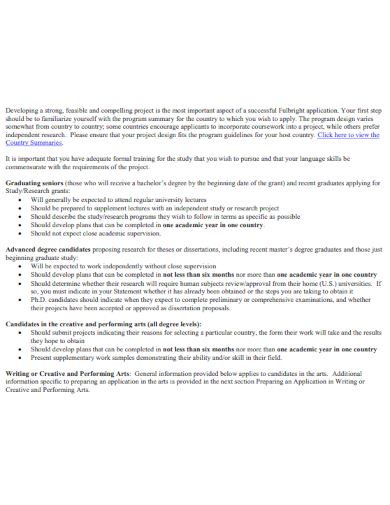
2. Sample Study Plan for Scholarship Application
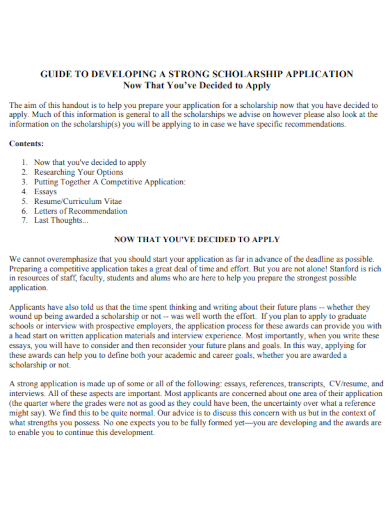
3. Bachelors Study Plan for Scholarship Application
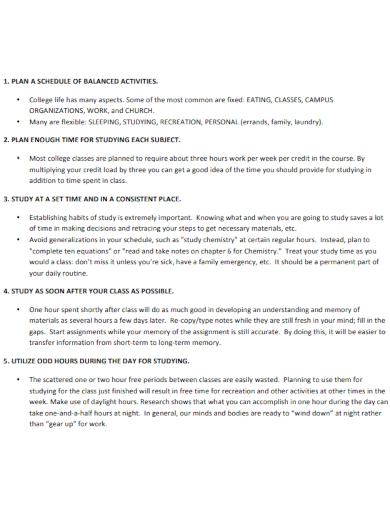
4. Masters Study Plan for Scholarship Application
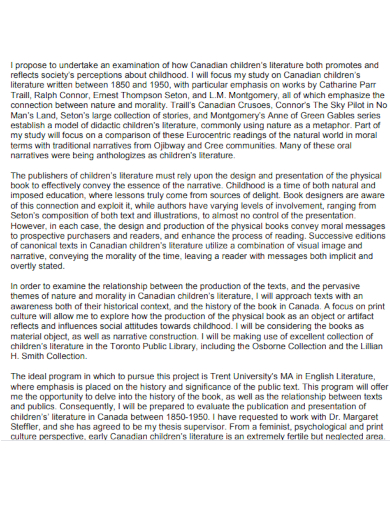
5. Study Plan for Abroad Scholarship Application
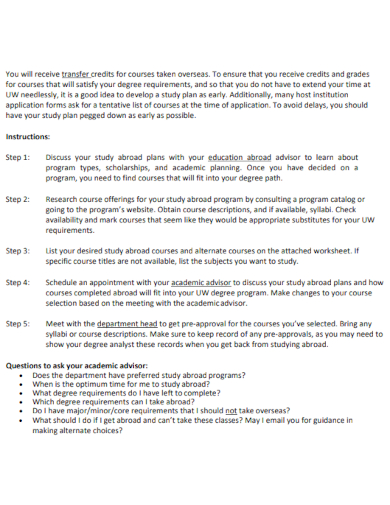
Importance of a Study Plan in Scholarship Applications
Evidence of Proactivity : It provides proof that the applicant is proactive about their education and not just academically competent but also well-organized and thoughtful.
Confidence Booster for Committees : Scholarship committees feel more confident about investing in students who show clear intent and preparedness towards their educational endeavors.
Framework for Success : The study plan acts as a framework that can significantly enhance the applicant’s ability to achieve their educational targets efficiently.
How to Devise an Impressive Study Plan for Scholarship Application?
There are probably hundreds of other hopeful students like you who are also aiming to get the scholarship. If you are one of many, rousing the committee will be a difficult task. One weakness or mistake, and your application documents might end up in the paper shredding machine. Ensure to avoid this unfortunate fate by showing off your essay writing skills with your study plan.
1. Highlight Your Achievements
The first thing you should consider in composing your study plan is to outline your academic achievements and academic background. Yes, you are writing this to impress, but you should also remember to include only honest facts of yourself. If you have received any award certificates for particular programs, you should detail them in your essay. Don’t forget to discuss how these attainments contributed to your decision in choosing their school, the scholarship, and the program/degree.
2. Set Your Academic Goals
The next step in your essay writing process is to talk about your long-term and short term academic goals . The committees will give extra attention to this segment. They will evaluate this as a determining factor to determine whether you are deserving of the scholarship or not. You should also align your academic goals to the degree or program you chose to take.
3. Provide a Timeline
Now that you have presented your goals, you should set aside a schedule or a timeline for each item you listed in your objectives. It is important to stay realistic and to know your limits. Do not set a career timeline you cannot follow. It will put you at a disadvantage in the long run.
4. Detail Your Strategic Study Methods
After discussing what you want to achieve and the period to accomplish it, you should answer the how question. That said, you should enumerate a detailed list of the fruitful study strategies and habits you are willing to implement to achieve what you have written in your study plan. If your applying for an overseas scholarship, you should also include how you plan to learn their language.
What Should I Write in My Study Plan?
Outline your educational background, academic goals, detailed schedule, resource utilization, extracurricular activities, and strategies for maintaining physical and mental health. Emphasize how these elements help achieve your academic objectives.
How Do You Write a Future Study Plan for a Scholarship?
Include long-term academic targets, describe the preparation for major exams, detail intended use of institutional resources, and explain how you will engage with campus life and external opportunities to enhance your career prospects.
How Do I Create a Study Plan?
Start by setting clear, measurable academic goals. Break down your daily and weekly commitments, allocate time for revisions and breaks, utilize academic resources effectively, and incorporate time for extracurriculars to maintain a balanced schedule.
How Can I Focus 100% on Studying?
Create a distraction-free study environment, set specific goals for each study session, use techniques like the Pomodoro Technique for maintaining focus, and incorporate short breaks to prevent burnout and keep your mind fresh.
What is the 9 8 7 Study Method?
This method involves studying for 9 hours a day using a mix of 3 hours for new topics, 3 hours for review, and 3 hours for practice problems, followed by 8 hours of sleep, and 7 hours of relaxation, meals, and personal tasks.
What is the Study Plan for Student?
A student’s study plan should include a realistic schedule that balances study hours with classes, assignments, and exams. It should also outline strategies for effective learning, such as active recall and spaced repetition, and integrate time for rest and extracurricular activities.
How is a study plan essay from a study timetable?
The glaring difference between a study plan essay and a study timetable lies in their formatting. A study plan follows an essay structure, while a study timetable is a visual presentation of your daily or weekly study schedule . In addition to that, a study plan is a scholarship essay that presents your academic goals for the whole duration of your studying in a particular school, while the latter aims to achieve a daily or weekly goal.
What are examples of academic goals for a study plan?
Setting your academic goals in your study plan can be considerably influenced by the type of scholarship you want. If you are applying for a scholarship for a post graduate school program, you can include publishing a educational research in your goals. On the other hand, if you want to apply for an undergraduate scholarship, you can enhance your leadership and communication skills by joining extracurricular clubs and activities. You can also aim to achieve a certain GPA that you think is reachable for you
What are some productive study methods?
The first tip that you should consider is to look for a study-friendly place. If you have not discovered what type of learner you are, then you should conduct a self-assessment. Doing this will help you know what kind of methods are appropriate for you. In addition, based on the results of your assessment, you should prepare learning materials accordingly. If you learn better when you write, you can prepare notebooks for your notes. On the other hand, if you are an auditory learner, you should opt to prepare abooks. To make studying a routine, you can also construct a five day study plan .
It’s a no-brainer that underprivileged students do not have the same chances of getting a quality education as students from a well-off family. Despite that, there are sponsors, organizations, and universities willing to help open the doors of opportunities to these students. That said, once you come across this situation, exhaust all your efforts by composing an outstanding study plan for scholarship application.
Text prompt
- Instructive
- Professional
Create a study plan for final exams in high school
Develop a project timeline for a middle school science fair.

- Project Management
Home » Free Resources » »
Project Management Tips: What is a Feasibility Study?
- Written by Contributing Writer
- Updated on July 23, 2024
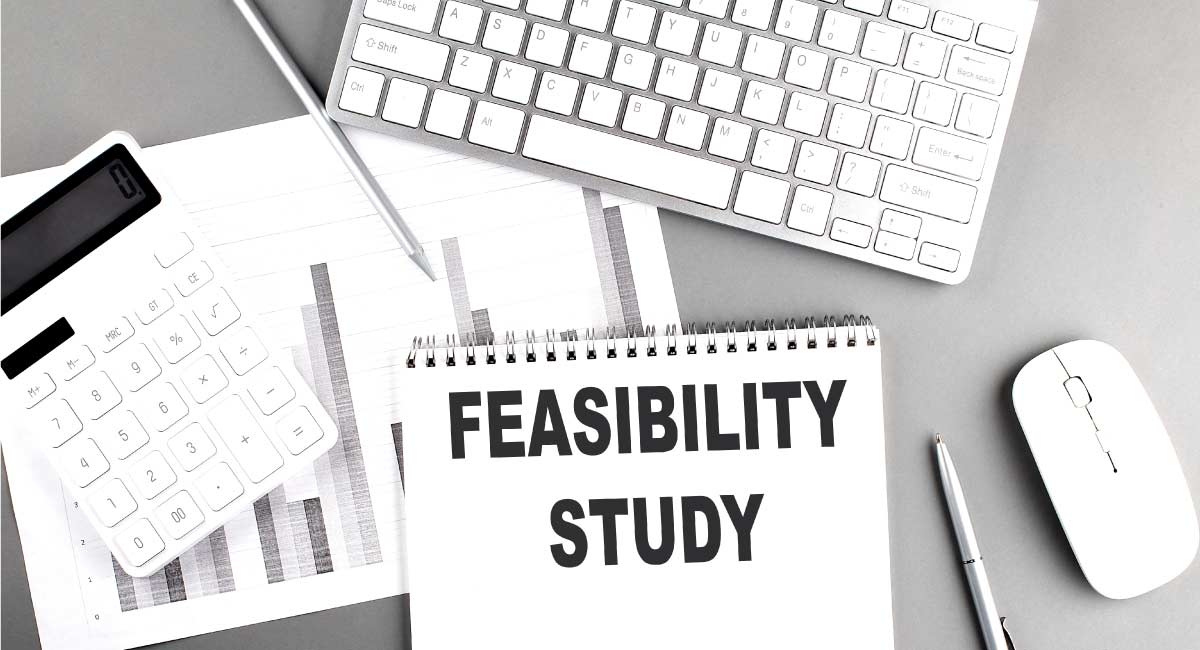
Projects fail; that’s just a fact of life for many project managers. However, many failures can be avoided with proper planning and assessment, starting with a comprehensive feasibility study. This step examines factors like market viability, objectives, obstacles, and resource requirements, giving project leaders and stakeholders a clear picture of whether their proposed project is viable and worth pursuing.
In this article, we delve into the importance of feasibility studies in project management and offer practical insights into their application. We will also recommend an industry-recognized project management program that will help you acquire the skills essential to succeed in a career as a project manager.
What is a Feasibility Study?
A feasibility study thoroughly assesses whether a proposed project can succeed. Business success hinges on ROI, which reflects the project’s profitability. This study examines a project’s practicality by analyzing its strengths, weaknesses, opportunities, threats, required resources, and chances for success. Two main factors considered are the project’s costs and expected returns.
Feasibility studies determine if a project is viable and likely to succeed. They evaluate legal, technical, and economic feasibility to ensure the project merits investment. Sometimes, projects are deemed unfeasible due to high resource requirements that outweigh potential earnings.
A well-designed feasibility study should cover the project’s background, product or service description, financial statements, operations and management details, marketing research, economic forecasts, legal considerations, and tax obligations. Typically, these studies precede technical development and project implementation.
Also Read: What is a Project Management Office? A Beginner’s Guide
Feasibility Study Examples
A local university was concerned about its science building, which was built in the 1970s. School officials wanted to assess the costs and benefits of expanding and upgrading the facility, given advancements in science and technology over the past 20 years. To do this, they conducted a feasibility study.
Officials explored various options, considering the costs and benefits of updating and expanding the science building. They were concerned about project costs and public opinion, especially since the proposed new building would be larger than the current one. Similar proposals had previously faced community board rejection, raising legal and zoning issues addressed in the feasibility study.
The study examined technology requirements for the new building, potential student benefits, and long-term sustainability. Modernizing the facility would enhance scientific research capabilities and improve academic programs, potentially attracting new students.
Financial projections detailed the project’s scale, costs, and fundraising strategies, such as issuing bonds and using endowment funds. These projections highlighted how the upgraded science program could increase student enrollment, boosting tuition and fee revenue.
The feasibility study confirmed that expanding and modernizing the building was feasible. Without it, school administrators would not have known the viability of their expansion plans.
What is a Feasibility Study, and Why is it Critical for Project Managers?
Here are some key benefits of conducting a feasibility study:
Identifies New Opportunities
Conducting a feasibility study uncovers potential market gaps, technological advancements, or operational efficiencies that the project could capitalize on, offering fresh perspectives and innovative ideas.
Provides Critical Information for a “Go/No-Go” Decision
It furnishes decision-makers with comprehensive insights into project feasibility, including cost-benefit analyses and risk assessments, which are crucial for determining whether to proceed with the project.
Narrows Business Alternatives
By evaluating various project options and their potential outcomes, a feasibility study aids in streamlining decision-making processes, enabling organizations to focus on the most viable and profitable opportunities.
Identifies a Strong Reason to Undertake the Project
A feasibility study validates the project’s rationale by thoroughly analyzing market demand, financial viability, and strategic alignment, ensuring it aligns with organizational goals and objectives.
Enhances Success Rate by Evaluating Multiple Factors
A feasibility study examines market dynamics, technical feasibility, and resource availability to enhance project planning and implementation strategies and improve the likelihood of achieving project goals.
Aids Decision-Making on the Project
Armed with comprehensive data and analysis from the feasibility study, project stakeholders can make informed decisions at every stage of the project lifecycle, from inception to execution, ensuring alignment with overall business objectives.
Identifies Reasons not to Proceed
By identifying potential risks, feasibility studies highlight obstacles and challenges hindering project success, allowing organizations to mitigate these issues or reconsider the project altogether.
In addition to these approaches, some projects require other constraints to be analyzed:
- Internal Project Constraints: These include technical, technological, budgetary, and resource constraints.
- Internal Corporate Constraints: Including financial, marketing, and export considerations.
- External Constraints: Logistics, environmental factors, and laws and regulations.
Also Read: AI for Project Management: Creating More Efficiency, Accuracy, and Better Results
Purpose of a Feasibility Study
A feasibility study is a crucial initial step in launching a new business. It involves thoroughly examining the likelihood of success for a proposed business venture. The study aims to provide essential information that guides business owners in making well-informed decisions about their new endeavors.
Key questions addressed by the feasibility study include:
- Who is the target market for this business?
- Who are the main competitors?
- What are the startup and operational costs involved?
- What are the possible risks and benefits linked to this venture?
- How much income can the business generate?
- What are the projected profits and potential losses?
- What growth opportunities exist within this industry?
What is a Feasibility Study? Examining Types
Five distinct types of feasibility studies examine different aspects, outlined below:
Technical Feasibility
This evaluation focuses on the organization’s technical resources. It determines if existing technology can support the project and assesses the technical team’s capability to implement the proposed system. For example, implementing technology like Star Trek’s transporters would not be technically feasible.
Economic Feasibility
This assessment involves a cost-benefit analysis to gauge the project’s financial viability. It helps organizations understand the costs and economic benefits the project can deliver, thereby bolstering project credibility.
Legal Feasibility
This assessment checks if the project complies with legal requirements such as zoning laws or data protection regulations. For instance, a feasibility study might reveal that a proposed office building location doesn’t meet zoning requirements, saving the organization time and effort.
Operational Feasibility
This study analyzes whether the project can effectively meet the organization’s operational needs and ensures that the plan aligns with the requirements identified during the system development phase.
Scheduling Feasibility
This assessment determines the project’s timeline and ensures that it can be completed within the expected timeframe, which is critical for project success.
Once these areas are thoroughly examined, the feasibility analysis identifies potential constraints the project may encounter, including:
- Internal Project Constraints: Technical capabilities, technology requirements, budget constraints, and resource availability.
- Internal Corporate Constraints: Financial considerations, marketing strategies, and export regulations.
- External Constraints: Logistical challenges, environmental factors, and legal regulations.
Benefits of a Feasibility Study
Preparing a feasibility study for a project is a crucial step that helps project managers make informed decisions about investing time and money in the endeavor. Feasibility studies also enable company management to avoid risky business ventures by providing critical insights.
Another benefit of a feasibility study is its role in launching new ventures. It provides essential information on how a business will operate, potential challenges it may face, competitors in the market, and sources and amounts of funding. Feasibility studies aim to convince investors and banks whether investing in a specific business venture is worthwhile.
Also Read: Exploring Top AI Project Management Tools
What Is Included in a Feasibility Study Report?
When preparing a feasibility report, several factors are considered, including marketability, competition, financial stability, technology requirements, and ROI.
The findings of a feasibility study are summarized in a feasibility report, typically including these sections:
- Executive Summary : A concise overview summarizing the feasibility study’s key findings, conclusions, and recommendations.
- Specifications of the Item or Service : Detailed description outlining the proposed product or service’s features, functions, and attributes.
- Considerations for Future Technology : Exploration of technological trends and advancements that may impact the project’s implementation and sustainability.
- Marketplace for Goods and Services : Analysis of the target market, including size, demographics, trends, and competitive landscape.
- Approach to Marketing : Strategic plan detailing how the product or service will be promoted, priced, distributed, and positioned in the market.
- Organization/Staffing : Structure and staffing requirements, including roles, responsibilities, and organizational hierarchy necessary for project execution.
- Schedule : Timeline outlining key milestones, tasks, and phases required to complete the project within specified timeframes.
- Financial Forecasts : Projections of costs, revenues, cash flows, and economic performance expected throughout the project lifecycle.
- Recommendations Based on Research : The feasibility study findings provide conclusions and actionable recommendations that guide decision-making and future steps.
What is a Feasibility Study, and How Do You Conduct One?
When preparing a feasibility study, consider these key aspects:
- Define your target market and outline your strategy to reach them.
- Provide a detailed description of your product or service, emphasizing its uniqueness and necessity.
- Present your financial projections and explain your strategy for achieving profitability.
Tools for Conducting a Feasibility Study
While each project varies in goals and requirements, the following best practices are crucial for conducting a feasibility study:
- Conduct a preliminary analysis, gather relevant stakeholders’ input and explore alternative business scenarios.
- Ensure data integrity by asking critical questions during the initial phases.
- Conduct a market survey to assess demand and identify opportunities for the new concept or business.
- Develop an organizational, operational, or business plan detailing required resources, costs, and timelines.
- Prepare a projected income statement outlining revenue, operating expenses, and anticipated profits.
- Establish an opening day balance sheet to assess initial financial standing.
- Identify and address potential vulnerabilities or obstacles.
- Make an informed decision on proceeding with the plan.
Start Your Journey to Becoming a Skilled Project Manager
A feasibility study is essential for evaluating project viability. It guides informed decision-making and enhances project success rates by identifying potential challenges and opportunities. As an aspiring project manager, mastering feasibility studies is crucial for overseeing complex projects.
Get started by enrolling in a comprehensive project management bootcamp . This program helps you accelerate your project leadership journey. It’s a three-month online bootcamp featuring interactive classes, Harvard Business case studies, gen AI modules, and a practical capstone project. Ideal for aspiring project managers aiming to excel in complex projects.
You might also like to read:
How to Negotiate the Best Project Manager Salary
What is Enterprise Resource Planning, And How Does It Help Organizations?
What Are Network Diagrams in Project Management, and Why Are They Effective?
PMP® Exam Tips: A 2024 Guide
What is the Pomodoro Technique & How Does It Help in Time Management?
Leave a Comment Cancel Reply
Your email address will not be published. Required fields are marked *
Recommended Articles

Design for Six Sigma: Methodology, Tools, and More
Learn the basics of Design for Six Sigma with our detailed guide. From methodology to tools, discover how DFSS helps create high-quality products and processes from the ground up.

Demystifying Project Management Documentation
This article explores project management documentation, its uses, importance, types, tools, and best practices.

Exploring the Role of a Scrum Master in Project Management
This article covers a Scrum master’s role in project management, including what they are, what they do, roles and responsibilities, skills, and how to become one.
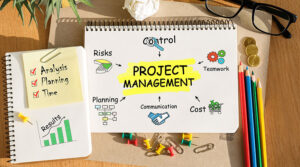
13 Project Management Principles and How to Use Them
Master the core principles of project management. Discover essential insights for effective project leadership and success.

12 Best Project Management Books You Must Read in 2024
Whether you’re an official project manager or someone who manages projects at work, it’s always helpful to learn some of the tools and techniques available. Check out this list of the best project management books for professionals at all experience levels.

What is a Project Management Office? A Beginner’s Guide
Project management offices are pivotal for project success in many organizations. But what is a PMO? Learn about their structure and roles and how they achieve a company’s project goals.
Project Management Bootcamp
Learning Format
Online Bootcamp
Program benefits.
- 25 in-demand tools covered
- Aligned with PMI-PMP® and IASSC-Lean Six Sigma
- Masterclasses from top faculty of UMass Amherst
- UMass Amherst Alumni Association membership
UVAccelerate
Accelerate your time to completion of a non-thesis Master’s degree by getting started now!
Who can apply?
Current UVA undergraduate and Sweet Briar College engineering science students can apply to a Master of Engineering (M.E.), Master of Computer Science (M.C.S.), or Master of Materials Science and Engineering (M.M.S.E.) degree program in the third year of your undergraduate studies. These programs require 30 credits of coursework (35 credits for biomedical engineering) as part of an approved plan of study, and with the right planning, you may be able to get a head start on taking graduate-level courses while finishing your bachelor’s degree.
Save time and money by accelerating your time to completion of a master’s degree!
How it works
Interested UVA undergraduate students should apply to UVAccelerate in March of your third year. Once admissions decisions are released, students admitted through the UVAccelerate program will be offered academic advising from graduate program faculty to identify the fastest path to your master’s degree. While applying in your third year of undergraduate studies may seem early, getting an early admissions decision and personalized advising allows you to minimize your time to degree by taking advantage of things like advanced placement credit and undergraduate electives. Some students who participate in UVAccelerate are able to earn a master’s degree in as little as one additional semester beyond their bachelor’s degree.
Benefits to you
By earning your master’s degree in engineering, you have access to more interesting and challenging job opportunities, accelerated career advancement, and higher earning potential throughout your career. UVA Engineering graduate students report an average starting salary $30,000 higher than bachelor’s graduates in their first job after finishing their degree. UVAccelerate can help you get there as quickly as possible!
How to apply
Complete a graduate application through our online application system starting as early as December 1st . On the Program page of the online application, be sure to check the box indicating that you’re applying through the UVAccelerate program. We also made it easier for you to apply by waiving two of the three required letters of recommendation, making the GRE test-optional, and waiving the $85 application fee for UVA Engineering and BACS undergraduates who apply to UVAccelerate!
Degree Programs and Contacts:
- Biomedical Engineering (M.E.) | Don Griffin
- Chemical Engineering (M.E.) | Gary Koenig
- Civil Engineering (M.E.) | Jose Gomez
- Computer Engineering (M.E.) | Mircea Stan
- Computer Science (M.C.S.) | Felix Lin
- Electrical Engineering (M.E.) | Zongli Lin
- Materials Science and Engineering (M.M.S.E.) | Leo Zhigilei
- Mechanical and Aerospace Engineering (M.E.) | Gavin Garner
- Systems Engineering (M.E.) | Robert Riggs
UVA Engineering Partners with Sweet Briar College on Accelerated Path to Graduate Degree
Through the new UVAccelerate partnership, Sweet Briar engineering students can get a jump start on a Master of Engineering graduate degree.
Frequently Asked Questions
Completing the application.
Can I apply to a different graduate program than my undergraduate major?
Yes. You are not limited to your undergraduate major and are free to apply to any graduate program of your choosing.
Am I eligible to apply for UVAccelerate in my second year if I plan to complete my program in three years?
No. The program is designed specifically for third-years. If you are a second-year interested in pursuing an M.E., we encourage you to apply for your program of interest during the standard admissions cycle.
How many letters of recommendation are required as part of my UVAccelerate application?
Only one letter of recommendation is required; however, you are welcome to submit additional recommendation letters if preferred.
Does my letter of recommendation need to be from a faculty member?
Your letter of recommendation does not need to be from a faculty member. However, if you request a faculty member write your recommendation letter, consider including faculty with whom you have taken more than one course or worked closely with on projects. For tips on applying to a graduate program, please visit our Graduate Admissions website here .
What is the cost associated with applying to UVAccelerate?
The UVA Engineering graduate application fee is $85; however, the application fee is automatically waived for all SEAS and BACS undergraduate students applying to the program.
Admissions Decisions
How soon will I be notified of my admissions decision?
Admissions decisions are typically made within 30 days of the March 1st application deadline. Once a decision has been made, you will receive an email that will direct you to the application portal.
I just received a letter stating that I have been admitted to UVAccelerate. What are my next steps?
Congratulations! Please log in to the application portal, respond to your offer of admission, and look forward to ‘next steps’ emails from the Office of Graduate Programs.
Cost and Tuition
How much does the master’s program cost?
For information regarding Tuition & Fees, please visit the SEAS Graduate Admissions website here . Some graduate programs do offer scholarships; however, the Master of Engineering program in the Engineering School is self-funded.
Do I have to pay to take graduate courses as a UVAccelerate student?
Graduate courses are typically covered by undergraduate tuition. However, this is not the case for all undergraduate students. Please contact Student Financial Services ( [email protected]) to verify that graduate courses will be covered by your tuition and/or financial aid.
Students using VA benefits should contact UREG-Veterans Benefits ( [email protected]) to verify if your benefits will cover the tuition costs for graduate courses.
Prospective Student Inquiries
Can I be a part-time student in the master’s program?
Yes. Once you’ve matriculated into the master’s program, you can switch enrollment status from full-time to part-time.
Can I transfer to a different graduate program within the Engineering School?
If you're a current UVAccelerate student and you decide to transfer to another program within UVA Engineering before starting the master’s program, you will need to receive approval from both programs. Please contact [email protected] to notify them of your request, and they will assist you with the program transfer process.
Once you start your master’s program, you may not transfer to a new program within UVA Engineering until you have spent at least one semester in your current program. Any student wishing to transfer after this minimal time period must complete the Request Program Plan Change Form . Graduate Student forms are on the Office of Graduate Programs website here .
Can I work and still pursue a master’s degree?
Yes. If you cannot take courses on-ground and have matriculated into the master’s program, you may want to consider applying to the Virginia Engineering Online (VEO) program instead. VEO is designed for working professionals looking to receive their Master of Engineering degree online. For more information about this option, please visit the VEO website here .
Can I take online graduate courses?
If you are an on-grounds undergraduate student or a master’s student, you will not be able to enroll in online courses. Online courses are offered only to VEO students.
Current Student Inquiries
I’m on track to graduate with my undergraduate degree and master’s degree. Can I graduate with both degrees in the same semester?
Per university policy, you cannot graduate with two degrees in the same semester. If you’re on track to graduate with both degrees, please contact [email protected] , and we will assist you with the next steps.
I am a current UVAccelerate student that will soon be graduating and (1) have decided to attend another university for graduate school or (2) received a job offer that will impact my ability to matriculate in the fall semester as expected. What steps should I take?
The program is created to be nonbinding as we are very understanding that plans can change. Please inform your graduate advisor and contact [email protected] once you receive this information so the update to your admissions status can be reflected in our records.
How do I transfer graduate courses I’ve taken as an undergraduate student to my master’s program?
In the final semester of your undergraduate studies, you will receive an email from the Office of Graduate Programs regarding the process for transferring graduate courses you’ve taken as an undergrad to your master’s program. Please note course credits cannot be counted toward both your undergraduate and graduate record.
Enrollment Inquiries
How many graduate courses can I enroll in as a UVAccelerate student?
Each school has its policy on how many credit hours an undergraduate student can enroll in each semester. SEAS students are not to exceed the max of 19 credit hours without special permissions, and BACS students are limited to 15 credits during initial course enrollment and 17 credits during open enrollment. For more information regarding guidelines for course enrollment, please visit the University Registrar's website here or refer to your school's undergraduate record.
Please note, most UVAccelerate students take an average of 1-3 graduate-level courses per semester.
Is the graduate course enrollment process the same for both SEAS and BACS students admitted to UVAccelerate?
Yes. Enrollment for graduate courses is handled for both SEAS and BACS students by the SEAS Undergraduate Registrar.
What is the process for enrolling in graduate courses as a UVAccelerate student?
5000-Level Graduate Courses
UVAccelerate students planning to enroll in 5000-level courses do not need special approvals to enroll.
6000-Level Graduate Courses
UVAccelerate students planning to enroll in 6000-level graduate courses will require special approvals and will need to submit the “Undergraduate Request to Take Graduate Course Form” to the SEAS Undergraduate Registrar by the date provided in the ‘registration next steps’ email. You should expect to receive this email from the Office of Graduate Programs at least two weeks prior to ENU open enrollment.
Please note, open enrollment will vary depending on the semester in which you plan to take graduate-level courses. We ask that you refrain from submitting the referenced form until you receive communication on the next steps from the Office of Graduate Programs.
I have been admitted to the program but plan to enroll in graduate courses in my final semester. What steps should I take?
UVAccelerate provides you with the opportunity to take graduate courses where there is space in your course schedule regardless of semester. If you decide to take graduate courses during one semester and not the other, please reach out to us at [email protected] so we can ensure the most updated information is reflected in our records.

IMAGES
VIDEO
COMMENTS
Example: Planning year 2 of a 3-year PhD. Maria completed her first round of data collection according to plan, and starts the second year of her PhD with a lot of material. In her second year, she will focus on turning this data into two journal articles. Months 1-2: Maria works on her data analysis.
PhD Plan of Study Template (Effective Fall 2019) PhD Plan of Study Your Name Date (Note that each time your committee meets, you should present them with an updated plan, and document such updates. Please remember to change the date with each revision) Department of Communication and Film University of Memphis Advisory Committee COMM Prof., Advisor
A PhD research plan or schedule can be prepared using the GANTT chart which includes a month, semester or year-wise planning of the entire PhD research work. First, enlist goals and objectives. It's not about your research objective enlisted in your proposal. I'm talking about the objectives of your PhD.
A well-made study and research plan is an essential part of a good application for doctoral studies. The applicant should develop it in collaboration with the prospective supervisor. The study and research plan has three sections: 1. Research plan of up to 5 pages, including a description of the objectives and
Actionable PhD research plan template. Now prepare a timeline— in how much time a particular goal should be achieved. For example, 6 Months for sampling (Including, ethical approval, approval from sampling authority, consent, preparation and arrangement for utilities). Another is sample collection— 3 Months which isn't covered in the 6 ...
A successful PhD journey begins with a solid plan that includes a PhD timeline. A thought-through and well-designed PhD timeline requires some time but can be accomplished in a few simple steps. Contents Why a clear PhD research timeline mattersStep 1: Decide what to include in your PhD timelineStep 2: Discuss your provisional PhD timeline
A Template To Help You Structure Your PhD's Theoretical Framework Chapter. In this guide, I explain how to use the theory framework template. The focus is on the practical things to consider when you're working with the template and how you can give your theory framework the rockstar treatment. Use our free tools, guides and templates to ...
Skim them to identify which of the elements in the Introduction model on page 9 are present in each one. Label the main parts B (Background to the Research), RES (the Research), and REP (the Report). Then see which of the more detailed labels (e.g. identifying a research 'gap' or aims) you can apply.
Project description. The description should be one to three pages, written by the PhD student and approved by the supervisor. The description may be included in the form, or attached as an appendix. Start with an introduction describing the project in a broader context. Give the background and motivation for the topic of the PhD project.
Uncharted Territory. We start the conversation by trying to understand why planning is so difficult and so rare for PhDs. "They've never done a PhD so they don't know what's coming," Kearns observes. "And your previous education doesn't prepare for research.". He continues, "Research by its nature is uncertain. Things go wrong.
The Profs' PhD application tutors can also provide relevant example research proposals and support to help you structure your own PhD research proposal in the most effective way. More than 40% of all of our tutors have PhDs themselves, with many having worked as university lecturers, thesis supervisors, and professors at top universities ...
Therefore, in a good research proposal you will need to demonstrate two main things: 1. that you are capable of independent critical thinking and analysis. 2. that you are capable of communicating your ideas clearly. Applying for a PhD is like applying for a job, you are not applying for a taught programme.
Guidelines for how to make & use the timeline throughout your PhD. 1. Example & download: I draw below an example for the institute where I did my PhD: the Institute of Biology at the University of Fribourg in Switzerland. Therefore, it is designed for a 4-year PhD program with annual committee meetings and for students who spend a lot of time ...
A D: EXAMPLE PLANS OF STUDY. 0800 EXAMPLE PLANS OF STUDYStudents must take 75 total units to gradu. te with a PhD in Economics.Core courses: 24 units Workshop courses: 27 units, of which 9 need not be for a letter grade Seminars: 6 units Dissertation: 18 units Minor co. rses: variable,
Nursing PhD Sample Plan of Study The following plan of study option is based on three (3) courses per semester. Each student's program of study will be determined in conjunction with the student's academic advisor. Year 1: Fall NURS7500 Inquiry and Nursing This course introduces students to the process of intellectual inquiry.
PhD Study Plan. September 2006; September 2006; Authors: Sune Høgild Keller. Rigshospitalet; ... An example is the above mentioned . Ph.D. study groups Pattern Recognition and Image Ca non.
Purpose of the PhD research plan. ReferencesPurpose of the PhD research planDevelop a PhD project with realistic goals that can be achieved within the time. ame of the PhD period (normally 3-4 years).Ensure that the PhD student and PhD supervisor(s) are aligned wrt goa. of the project and the work plan/schedule.
your study plan. Your study plan should be submitted on VandalWeb before the end of your second year of enrollment in your PhD program. You may change the study plan at any time during your time as a student, if needed. The Graduate Faculty of the University of Idaho have set the following minimum requirements for a doctoral degree:*
Ph.D. Program Plan (including qualifying exam committee): Fall of the G2 year. In consultation with the research advisor, the student will submit the Ph.D. Program Plan form by mid-November, preferably earlier. The final program plan serves two purposes: (1) it updates the prospective program plan by noting any revisions to the ten courses to ...
Starting on PhD research is a big step in a researcher's academic journey, and submitting a research proposal is a significant part of it. Indeed, many PhD scholars seek guidance on how to write a PhD research proposal, which is the foundational document that outlines the scope, objectives, and methodology of their prospective doctoral study.This article takes a look at the essential ...
Nimesh Lamsal. This study plan had been prepared in 2014 in order to seek admission in PhD in English at a university with a good world ranking, focus on interdisciplinary studies, and that honours humanities programs. Because of the various circumstances ahead, the project was not taken by the universities I approached.
Objective: To thoroughly understand the criteria and expectations of the scholarship. Action Plan: Review the scholarship guidelines weekly to ensure all requirements are met and align activities to the scholarship's objectives. 2. Setting Academic Goals. Objective: To achieve a GPA of 3.8 or higher each semester.
A feasibility study thoroughly assesses whether a proposed project can succeed. Business success hinges on ROI, which reflects the project's profitability. This study examines a project's practicality by analyzing its strengths, weaknesses, opportunities, threats, required resources, and chances for success.
These programs require 30 credits of coursework (35 credits for biomedical engineering) as part of an approved plan of study, and with the right planning, you may be able to get a head start on taking graduate-level courses while finishing your bachelor's degree. ... Please note, open enrollment will vary depending on the semester in which ...